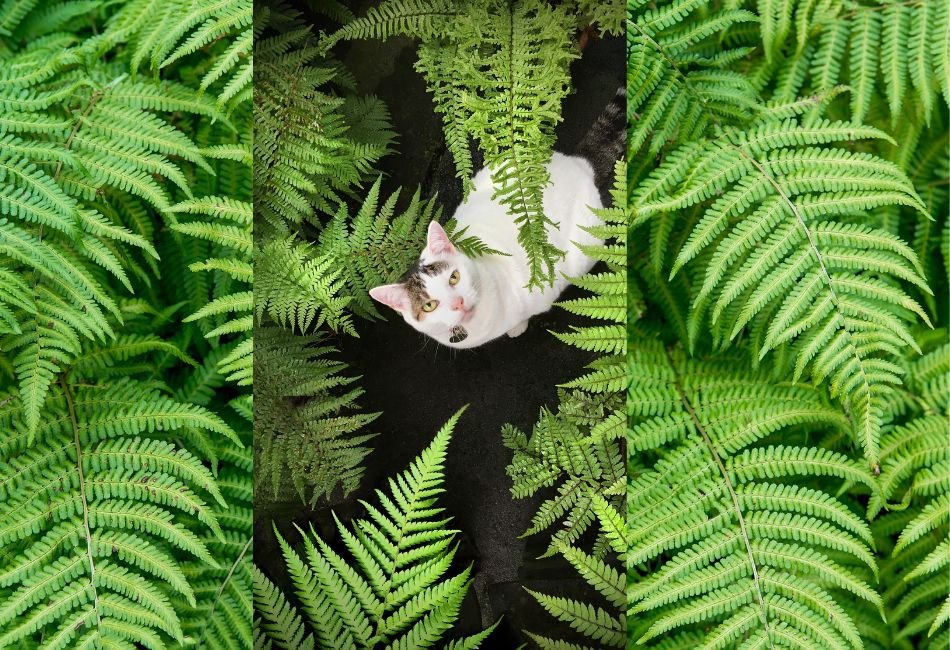That’s a great question: are ferns toxic to cats? The fact is that curiosity does NOT kill cats or people–having questions is how intelligent beings behave. Ignoring the answers, though, can be dangerous. Most true ferns are not toxic to cats.
Certain fern a-likes are, so we’ll go over that since cats have an inclination to sniff, nuzzle, taste, investigate, and bat at plants. Taking our exploration of cats and ferns a step further, we’ll show you how to use ferns to create a green wonderland for your beloved furbabies.
Are Boston Ferns Toxic to Cats?
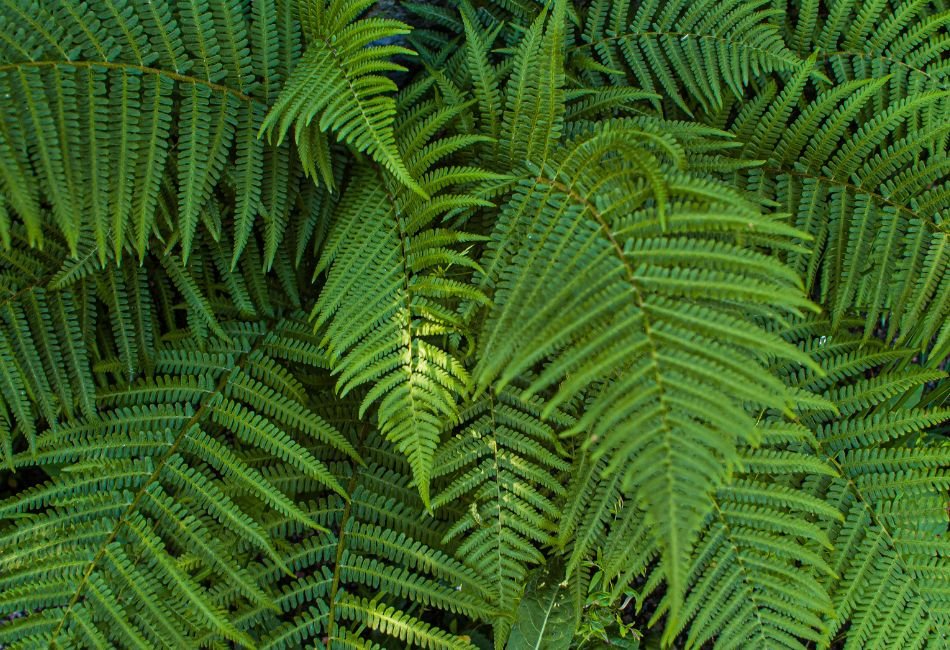
Boston ferns are true ferns that came on the scene only a few hundred years ago. They’re cat- and dog-safe. Because they’re often hung in pots, you can control the height so your felines won’t be tempted to take flying leaps into them.
Boston ferns are particularly good for detoxifying the air, according to a 1989 study by NASA scientists who were trying to figure out how to keep their astronauts healthy. Using a process called phytoremediation, true ferns are among several plants that absorb toxins from the air, soil, and water.
Are Ferns Poisonous to Cats?
Poisons and toxins are not quite the same even though we often use the words interchangeably. A poison is any substance causing harm to living organisms. A toxin is a poison produced by a living organism.
True ferns are a very ancient group of plants with roots, stems, and photosynthetic green leaves but reproducing by spores instead of seeds or flowers. They first appeared more than 360 million years ago, long before dinosaurs, but many dinosaurs loved to eat them! Yes, they were dinosaur-safe. In asking “Are ferns toxic to cats?”, very few true ferns are toxic to cats. However, not everything we call a fern is really a fern.
Whether plants are labeled “toxic” or “poisonous,” avoid them if you have cats. No worries, there are plenty of safe and healthful plants for our feline friends to enjoy. Are ferns toxic to cats? The bracken fern is one of the rare true ferns that is.
Also known as bracken, brake, female fern, fiddlehead, hog brake, and pasture brake, all parts are toxic. One botanical expert referred to this plant as “nasty.”
Are Asparagus Ferns Toxic To Cats?
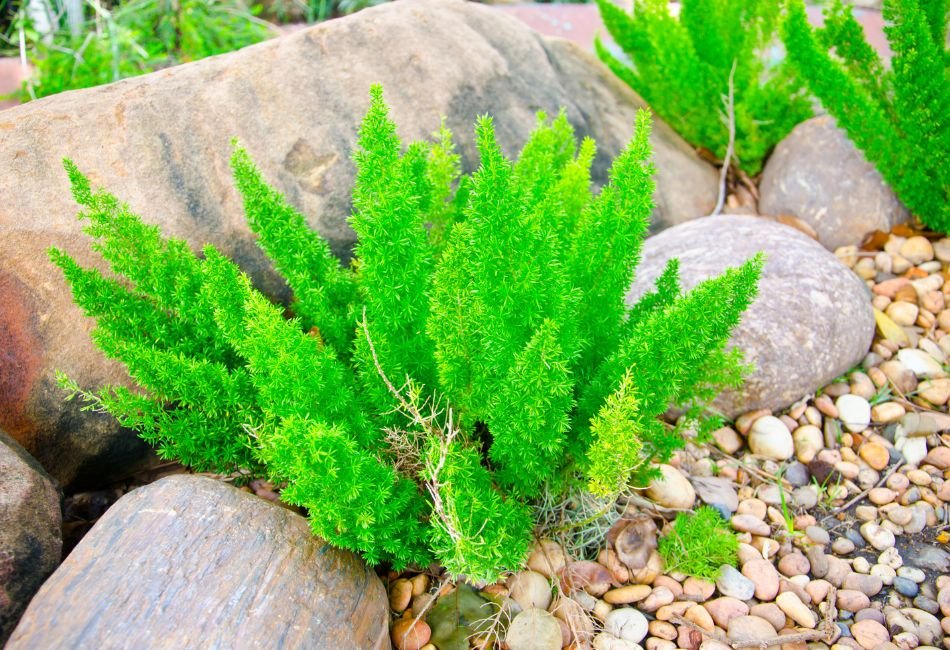
Asparagus ferns, also called emerald feather, emerald fern, sprengeri fern, plumosa fern, and lace fern, are NOT true ferns. They’re related to asparagus plants. Sapogenin, the offending toxic agent, is in the leaves as well as the berries. Not only can it cause abdominal pain, vomiting, and diarrhea, but also skin inflammation. Are ferns toxic to cats? Many non-true ferns definitely are.
Toxic Non-Ferns
Here are a few others in addition to asparagus ferns. Be especially aware of the hemlock fern because it is spreading quickly and is hard to kill:
- Hemlock fern: Not a fern but has fernlike leaves; also called deadly hemlock, poison parsley, spotted hemlock, European hemlock, California fern, and Nebraska fern, it is very common and very dangerous
- Foxtail fern: Also called Meyersii fern, it is related to asparagus and not a true fern
- Winter fern: Not a true fern but resembles one; extremely toxic
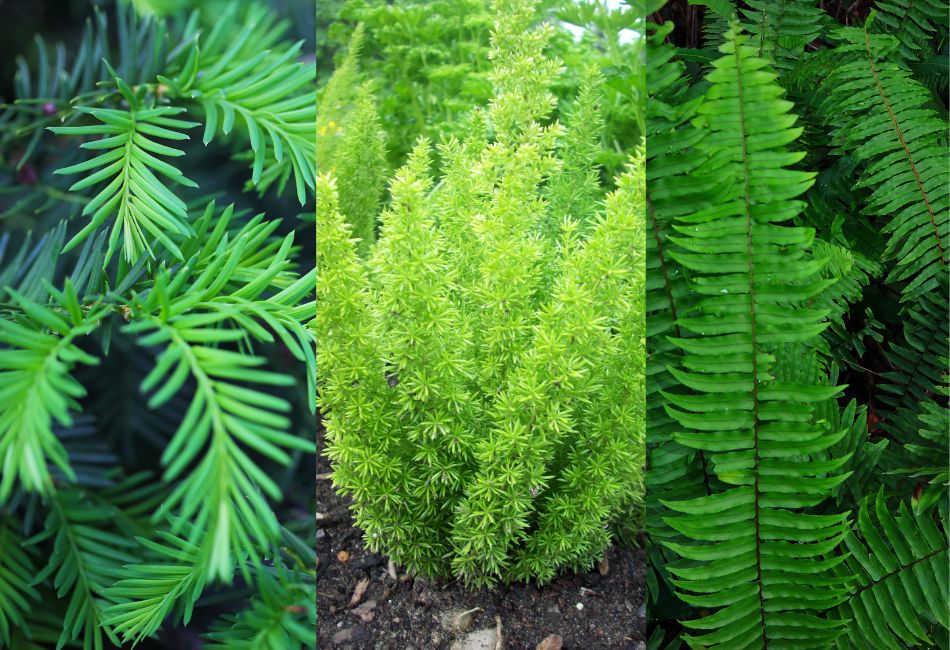
Why Cats Need Plants
You can take the cat out of the country but you can’t take the country out of the cat. Even domesticated animals have an inner need to connect with the kind of environment they evolved in. Think of all the ways cats use plants:
- As hidey-holes for privacy and shelter
- As cover for their cat boxes, water bowls, and food dishes
- As camouflage while they stalk prey
- As the feline equivalent of social media to sniff who’s been around: prey, enemies, invaders, potential mates, dogs, mice, etc.
- As soft, healthful spots to sleep, heal from injuries, give birth, and breathe naturally purified air
- As sources of nutrients and natural medicine
- As shade to provide a cool escape from the hot sun
- As signposts claiming territorial ownership
- As surfaces for stretching and cleaning their claws
- As places to play with toys and with each other
You can see how much live plants contribute to the well-being of all cat species. Are ferns toxic to cats or are they necessary for feline health? They’re very necessary! Next, read about indoor cat gardens and outdoor catios (“cat” + “patio” = catio!) and how ferns and other plants make them into kitty spas!
Creating an Indoor Cat Garden

Your home will determine the layout of your indoor cat garden. Remember: you can always make adjustments. In fact, your kitty will tell you how! You can use an entire room or just a corner. Set it up in the laundry room, sunroom, mudroom, or in a well-ventilated garage with a window.
Like most critters, cats are territorial and need their own space. Are ferns toxic to cats? Au contraire, they absorb contaminants and help cleanse the air. As you read the feline basic needs below, notice how many of them are met by having plants around. When assessing the environmental suitability of a potential cat territory, consider his or her basic needs:
- Safety
- Cleanliness
- Shelter
- Comfort
- A window to watch what’s happening
- Food and water
- A catbox or two
- Privacy
- Places to explore and climb
- A stable, comfortable temperature

In creating this special conservatory, what are YOUR basic needs?
- Ability to move freely without knocking things over
- Ease of providing food and water
- Stress-free catbox care (read our Happy Tails post for wonderful catbox tips from experts)
- Quick cleaning
- Space to provide plant care
- Stability of plant pots
- Beauty
- Comfortable seating
In other words, if you set things up to meet your cat’s needs as well as your own, you will have a stress-free haven you both can enjoy. What do you see in your mind’s eye for the perfect indoor garden? Check out online resources and talk with other cat people for creative ideas to personalize your indoor cat garden.
The Best of Both Worlds with a Catio
Catios are just what you might guess they are: an enclosed patio designed for the safety and happiness of cats to be protected while experiencing the great outdoors. You apply the same principles as you would for indoor cat gardens but you can incorporate a greater number of plants including outdoor plants. If you’re still concerned (Are ferns toxic to cats?), read through this Happy Tails post with tips on using a variety of safe plants to beautify the catio space.
We’ve given you links describing beautiful cat-safe plants for decorating your indoor garden or catio. Next comes a list of nourishing herbs and grasses that most cats find irresistible. They’re pretty easy to grow, too.
Catiospaces.com
PROMO Code for 10% OFF Catio Designs
Code: TIPSFORHAPPYTAILS
SuperGood Plants For Cats
You asked, “Are ferns toxic to cats?” but now you know that true ferns aren’t. Ferns are beautiful but not especially tasty. The herbs below are nutritious, although most seeds aren’t easily digestible for cats and many are toxic. Cat grass is usually a blend of different young grasses to be eaten before they send up seed spikes. All of these nutritious plants are ideal in indoor gardens and catios for sniffing, snacking, and even napping:
- Alfalfa grass: Fresh green alfalfa, not hay, is a good cat grass that may prevent and treat some feline kidney diseases
- Barley grass: Sprouted barley before it goes to seed
- Basil: Cat-safe and enjoyed by many
- Bean sprouts: Cat-safe and enjoyed by many
- Bermuda grass: Most clean, fresh, untreated lawn grasses are safe for cats
- Carrot greens: Cat-safe and enjoyed by many
- Catnip: Feline stress-reliever; the scent is often an aphrodisiac
- Cat thyme: Slow-growing but a soothing feline stress-reliever for cats who don’t respond to catnip
- Cilantro/coriander: Cat-safe and enjoyed by many
- Dill: Cat-safe and enjoyed by many
- Fescue: Most clean, fresh, untreated lawn grasses are safe for cats
- Flax: Young flax plants shorter than five inches are good for an occasional cat treat; flaxseed is generally safe for cats but many may have trouble digesting them, especially ailing or older animals; ground flaxseed is unsafe if not immediately refrigerated or if given in improper dosages, often causing diarrhea
More Feline Friendly SuperGood Plants
- Kentucky bluegrass: Most clean, fresh, untreated lawn grasses are safe for cats
- Lavender: Not only appealing to the feline sense of smell but also reportedly repels fleas
- Lemongrass: Affects some cats like catnip; it may also be antibacterial, antifungal, antiseptic, and antiparasitic as well as a digestive aid; the essential oil, however, is toxic
- Lemon balm: Not the same plant as lemongrass but it does have a pleasant citrus scent; safe when nibbled, chewed, or drunk as kitty tea; can help ease anxiety and stress-induced upset stomach; may repel flies and other insects
- Oat grass: Young sprouted oat plants not only provide several nutrients but also act as a calming digestive aid
- Parsley: Delicious and nutritious with reported properties supporting the immune system
- Rosemary: Enjoyed by many, also a natural flea repellent
- Rye grass: Young sprouted plants not only provide several nutrients but also act as a calming digestive aid
- Sage: Cat-safe and enjoyed by many
- Sunflower sprouts: Cat-safe and enjoyed by many
- Valerian: Energizing and activating (just the opposite effect on humans)
- Wheatgrass: Read below!
A Special Note about Wheatgrass for Cats
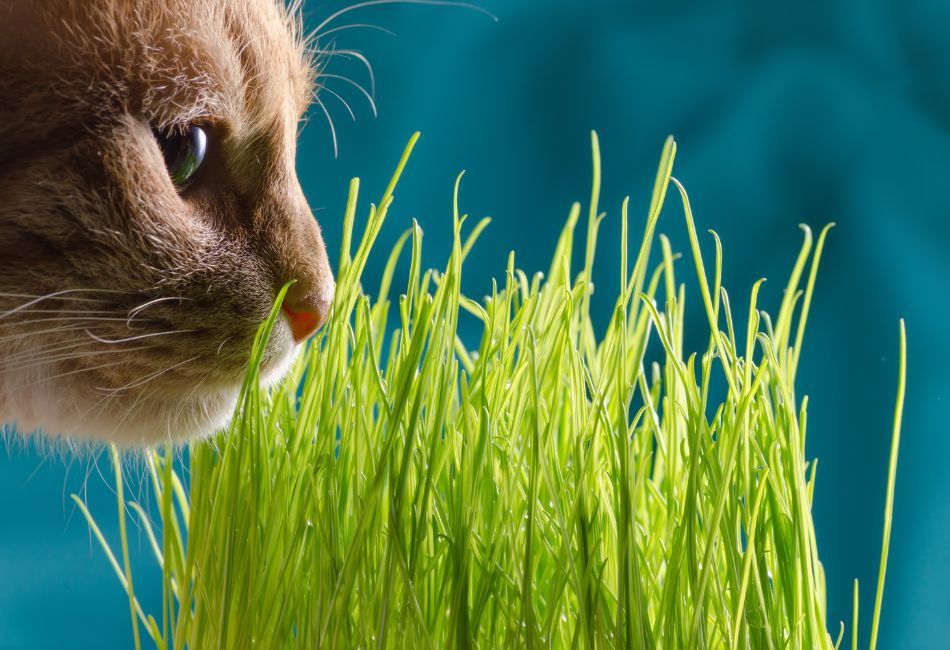
Although cats are obligate carnivores, meaning that they must consume prey animals for the bulk of their nutrition, they also ingest plant material; left to their own devices, they usually eat the green stomach contents of small herbivores and omnivores such as rabbits, birds, insects, rodents, and other critters.
They also voluntarily seek out grasses and certain veggies and fruits; among the grasses listed above, wheatgrass is especially beneficial.
The young green shoots of wheat plants are a rich gluten-free source of nutrients such as chlorophyll, antioxidants, fiber, and vitamins such as B6, E, folic acid, niacin, pantothenic acid, and riboflavin; offer minerals including manganese and zinc; act as a laxative by aiding indigestible matter such as feathers and hairballs to pass; given as a dietary supplement in small quantities, wheatgrass supports your cat’s immune system, helps scrub the teeth and gums, and aids in weight management.
Grow Your Own Wheatgrass For Yourself & Fur Babies
You can grow your own wheatgrass by starting with organic pesticide-free hard winter wheat seed or wheat berries. Rinse and drain, cover, then soak for 10 hours or overnight. Repeat three times. Prepare a deep tray by lining it with chemical-free paper towels covered with about two inches of moist organic compost or potting soil. Sprinkle the seeds on top in a single layer and press lightly into the soil. Water gently and cover with a few sheets of moist newspaper.
To germinate, the seeds need to remain damp for a few days. Spray the seeds and newspaper every evening to prevent drying out. On the fourth day, remove newspaper and place the tray in partial sunlight. Water daily, avoiding direct sunlight. In about a week and a half, a second blade of grass will emerge next to the first. Known as “splitting,” this indicates that the wheatgrass is ready to harvest if around six inches high.
Cut above the root and refrigerate in a bowl. One tray will usually yield two or three crops when watered daily. Give your cat several blades every day or every other day. If you’ve kept several trays growing, share them with your other pets, and juice some for yourself as well. It’s a fresh and healthful treat for your entire household.
If You Need to Call the Vet
Hopefully, you won’t have to seek veterinary help for a pet eating a toxic plant, but it’s good to prepare in advance. Many dangerous plants are very common but good resources are available. Establish a good relationship with a reliable veterinary office that listens. For an overview of kitty health and knowing when a vet trip is necessary, check out our Happy Tails post.
Bonus: at the end is a promo code for a discount on Catio designs, so check it out!
Do Cats Like Music and TV in Their Special Spaces?
After hearing so many reports from cat lovers, scientists discovered in their research that many cats do enjoy music. They seem to prefer classical music instead of loud, pounding rhythms but they respond the most to music composed specifically for felines. Because of their ability to hear higher frequencies than humans, feline tastes focus on high-register sounds that resemble their own vocalizations.
Their alertness is automatically triggered by movement, so it’s not surprising that many cats also love TV and video games, particularly those that involve topics they love. Can you guess? Other cats, prey animals, toys, and food. The stimulation is good for them as long as they don’t attack highly placed screens that crash down. (Note: May require a vet visit.)
Because of a Cats ability to hear higher frequencies than humans, feline musical tastes focus on high-register sounds that resemble their own vocalizations.
Have fun experimenting in your cat garden or catio to discover what pleases your furkids the most. Do an internet search to find music, TV programming, and games designed specifically for pets.
There’ll Be Peace in the Valley
You’ve heard the saying that when Mama ain’t happy, ain’t nobody happy. Cat psychology is not so different from human psychology. To put it another way, a household with happy cats is a happy household! What makes you happy? Having your basic needs met: air, water, food, safety, and comfort. What else?
Fun, opportunities to play, mental stimulation, an interesting environment, stability, variety, and things to look forward to. Even more, most critters (humans count as critters) need contact with their own kind. Specifically, friendship, bonding, belonging, family, a tribe, a pack, a community. Finally, a peaceful setting that allows each being freedom of choice.
Providing the feline members of your family with an indoor garden or an outdoor catio will satisfy every physical, psychological, and emotional need. Instead of constant expressions of frustration and desperation, there’ll be peace in the valley for all of you, just as Thomas A. Dorsey wrote for Mahalia Jackson’s gospel song.
Summing Up
Now you have the answer to your question “Are ferns toxic to cats?”. What’s more, you’ve learned about the fern family and about some of the toxic plants-called-ferns-but-aren’t. Best of all, you have ideas on how to put together an indoor garden or a catio for your beloved furbaby. In fact, when you spend time together in this haven, you and your feline companion will share peace and contentment. And your lush ferns will purify the air!
Glossary
- Cat grass: Any newly sprouted, untreated, cat-safe grass shoots without the seed heads, usually from a mixture of seeds for variety
- Conservatory: A glass-walled room, often with a glass ceiling, attached to a building and used as a sunroom or botanical garden
- Germinate: To sprout
- Obligate carnivore: Pronounced “OB-li-get,” the term refers to an animal that cannot survive without meat for the major part of its diet
- Omnivore: An organism that feeds on animals, plants, and a variety of other organic sources of nutrition
- Photosynthetic: Relating to photosynthesis, generally using chlorophyll and sunlight to make nutrients from carbon dioxide and water, releasing oxygen as a by-product
- Phytoremediation: The process by which certain plants absorb and metabolize certain toxins from the air, soil, or water
- Poison: Any substance causing harm to living organisms
- Sapogenin: A fat-soluble saponin-related compound derived from plants that plays a role in steroid synthesis; while not usually fatal, it does interfere with healthy processes while causing negative reactions; concentrated in leaves and berries of asparagus ferns
- Toxin: Any poison produced by a living organism
References and Resources
Pet-safe indoor plants:
https://nymag.com/strategist/article/indoor-plants-safe-cats-dogs.html#:~:text=%E2%80%9CSome%20ferns%20%E2%80%94%20such%20as%20Boston,out%20of%20your%20pet’s%20reach.
Cat grasses:
https://www.epicgardening.com/cat-grass/
How Music Affects Cats:
https://www.cnet.com/science/the-right-music-can-soothe-your-savage-beast-er-cat/

